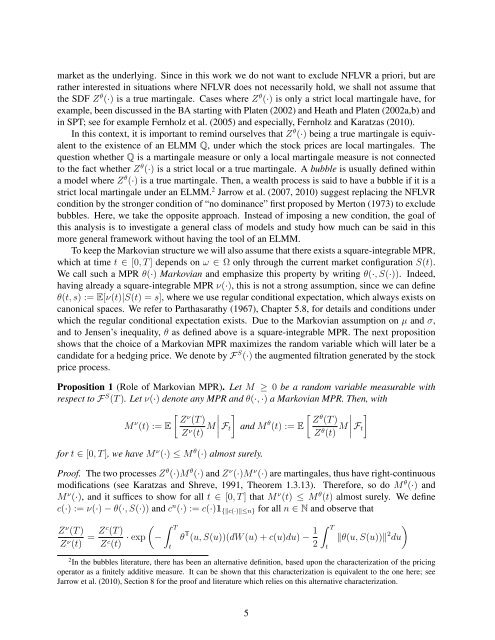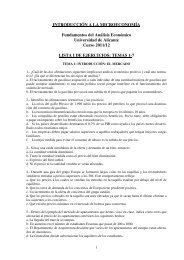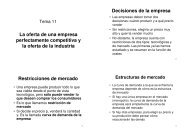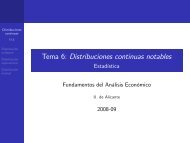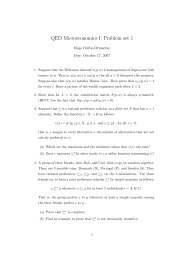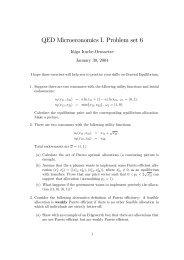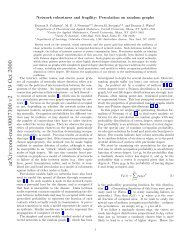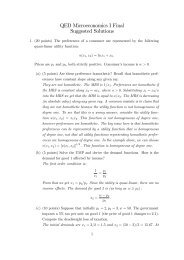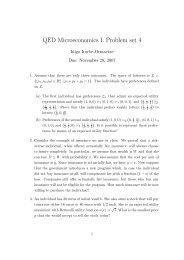Hedging under arbitrage
Hedging under arbitrage
Hedging under arbitrage
Create successful ePaper yourself
Turn your PDF publications into a flip-book with our unique Google optimized e-Paper software.
market as the <strong>under</strong>lying. Since in this work we do not want to exclude NFLVR a priori, but are<br />
rather interested in situations where NFLVR does not necessarily hold, we shall not assume that<br />
the SDF Z θ (·) is a true martingale. Cases where Z θ (·) is only a strict local martingale have, for<br />
example, been discussed in the BA starting with Platen (2002) and Heath and Platen (2002a,b) and<br />
in SPT; see for example Fernholz et al. (2005) and especially, Fernholz and Karatzas (2010).<br />
In this context, it is important to remind ourselves that Z θ (·) being a true martingale is equivalent<br />
to the existence of an ELMM Q, <strong>under</strong> which the stock prices are local martingales. The<br />
question whether Q is a martingale measure or only a local martingale measure is not connected<br />
to the fact whether Z θ (·) is a strict local or a true martingale. A bubble is usually defined within<br />
a model where Z θ (·) is a true martingale. Then, a wealth process is said to have a bubble if it is a<br />
strict local martingale <strong>under</strong> an ELMM. 2 Jarrow et al. (2007, 2010) suggest replacing the NFLVR<br />
condition by the stronger condition of “no dominance” first proposed by Merton (1973) to exclude<br />
bubbles. Here, we take the opposite approach. Instead of imposing a new condition, the goal of<br />
this analysis is to investigate a general class of models and study how much can be said in this<br />
more general framework without having the tool of an ELMM.<br />
To keep the Markovian structure we will also assume that there exists a square-integrable MPR,<br />
which at time t ∈ [0, T ] depends on ω ∈ Ω only through the current market configuration S(t).<br />
We call such a MPR θ(·) Markovian and emphasize this property by writing θ(·, S(·)). Indeed,<br />
having already a square-integrable MPR ν(·), this is not a strong assumption, since we can define<br />
θ(t, s) := E[ν(t)|S(t) = s], where we use regular conditional expectation, which always exists on<br />
canonical spaces. We refer to Parthasarathy (1967), Chapter 5.8, for details and conditions <strong>under</strong><br />
which the regular conditional expectation exists. Due to the Markovian assumption on µ and σ,<br />
and to Jensen’s inequality, θ as defined above is a square-integrable MPR. The next proposition<br />
shows that the choice of a Markovian MPR maximizes the random variable which will later be a<br />
candidate for a hedging price. We denote by F S (·) the augmented filtration generated by the stock<br />
price process.<br />
Proposition 1 (Role of Markovian MPR). Let M ≥ 0 be a random variable measurable with<br />
respect to F S (T ). Let ν(·) denote any MPR and θ(·, ·) a Markovian MPR. Then, with<br />
M ν � ν Z (T )<br />
(t) := E<br />
Zν (t) M<br />
�<br />
�<br />
�<br />
� Ft<br />
�<br />
and M θ � θ Z (T )<br />
(t) := E<br />
Zθ (t) M<br />
�<br />
�<br />
�<br />
� Ft<br />
�<br />
for t ∈ [0, T ], we have M ν (·) ≤ M θ (·) almost surely.<br />
Proof. The two processes Z θ (·)M θ (·) and Z ν (·)M ν (·) are martingales, thus have right-continuous<br />
modifications (see Karatzas and Shreve, 1991, Theorem 1.3.13). Therefore, so do M θ (·) and<br />
M ν (·), and it suffices to show for all t ∈ [0, T ] that M ν (t) ≤ M θ (t) almost surely. We define<br />
c(·) := ν(·) − θ(·, S(·)) and c n (·) := c(·)1{�c(·)�≤n} for all n ∈ N and observe that<br />
Zν (T )<br />
Zν (t) = Zc (T )<br />
Zc � � T<br />
· exp − θ<br />
(t) t<br />
T (u, S(u))(dW (u) + c(u)du) − 1<br />
� T<br />
�θ(u, S(u))�<br />
2 t<br />
2 �<br />
du<br />
2 In the bubbles literature, there has been an alternative definition, based upon the characterization of the pricing<br />
operator as a finitely additive measure. It can be shown that this characterization is equivalent to the one here; see<br />
Jarrow et al. (2010), Section 8 for the proof and literature which relies on this alternative characterization.<br />
5


